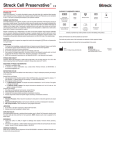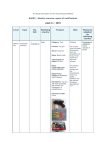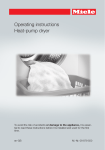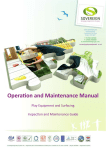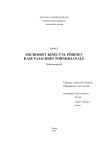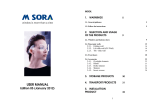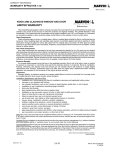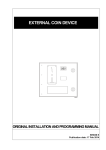Download - Livingwood Windows Ltd
Transcript
INSTRUCTIONS & MAINTENANCE CONTENTS USER MANUAL ...................................................................................................... 3 GENERAL RULES .................................................................................................... 3 1. OUTWARD OPENING WINDOWS ..................................................................... 3 a. Side hung window ........................................................................................ 3 b. Side guided (side projecng) window .......................................................... 4 c. Top guided window ...................................................................................... 4 d. Top swing window........................................................................................ 5 2. INWARD OPENING WINDOWS ......................................................................... 8 a. Side hung (turn) window.............................................................................. 8 b. Tilt and turn window.................................................................................... 8 c. Tilt only (boom hung) window ................................................................... 9 3. ENTRANCE AND TERRACE DOORS ................................................................... 10 a. Opening and closing the entrance door ...................................................... 11 b. Terrace doors ............................................................................................... 12 c. French doors – use of a passive door leaf .................................................... 12 4. SLIDING AND FOLDING DOORS ........................................................................ 13 a. Li and slide pao door ............................................................................... 13 b. Tilt and slide door ........................................................................................ 13 c. Folding door ................................................................................................. 14 5. SPECIAL PRODUCTS ......................................................................................... 15 a. Vercal sliding sash window ........................................................................ 15 b. Fireguard window ........................................................................................ 15 MAINTENANCE MANUAL ..................................................................................... 17 1. PRODUCT MAINTENANCE DURING INSTALLATION ........................................... 17 2. GENERAL MAINTENANCE INSTRUCTIONS (FOR THE END USER) ....................... 19 3. OUTWARD OPENING WINDOWS ....................................................................... 22 4. INWARD OPENING WINDOWS .......................................................................... 24 5. ENTRANCE AND TERRACE DOORS ..................................................................... 26 6. OUTWARD OPENING ALUCLAD DOORS ............................................................. 27 7. SLIDING AND FOLDING DOORS ......................................................................... 29 8. SPECIAL PRODUCTS ........................................................................................... 31 9. FACT SHEET for TEKNOL AQUA 1410-01 treated items ..................................... 33 10. FACT SHEET for GORI 605 treated items ........................................................ 34 USER MANUAL GENERAL RULES: Livingwood Windows Ltd supplies high quality windows and doors. Our products are designed to last for many years and in order to maintain good operaon it is important to adhere to the following: • ensure that no extra weight is hung on a window sash or door leaf • Please take care not to hit the window reveal (either plastered or mber) when opening and closing windows or doors. • ensure that no objects interfere with the opening between the sash and the jamb • if young children have access to a window it is important that the window is locked using the lockable handle • the window or door must not be le unsecured in the open posion in the event of a dra • a window or door must not be le in the open posion in the event of a strong wind or a storm • a window or door slamming shut may cause injury • when closing a window or door, make sure to not jam your hand between the sash and the jamb 1. 1. OUTWARD OPENING WINDOWS A. Side hung window Opening the window: The window will open if you turn the handle and then slowly push the window away from yourself. The hardware design includes a builtin fricon stay; fricon brake for the open posion. Depending on the type and dimensions of the product, fricon stay is either operated by friconal force or secured using the handle. The fricon stay secured using the handle is acvated when the handle is turned downward (see Figure 1.1). Closing the window: • to close the window completely, ensure that the hook on the espagnolee locates Figure 1.1. Side hung window with the inner hook of the catch. • the outer hook on the catch leaves the window in the micro venlaon posion. The window must not be le in the open posion in the event of a strong wind or a storm. 3 USER MANUAL B. Side guided (side projecng) window Opening the window: The window will open if you turn the handle and then slowly push the window away from yourself. To open completely, push the window using the handle as far as possible. The window is completely open once it has been turned approximately 90° from its inial posion. This moves the side of the sash nearest the hinges toward the centre of the window opening, leaving about a 15 cenmetre clearance between the sash and the jamb. Opening the window completely is normally required for cleaning. Closing the window: • to close the window completely, ensure that the hook on the espagnolee locates with the inner hook of the catch. • the outer hook on the catch leaves the window in the micro venlaon posion. The window must not be le in the open posion in the event of a strong wind or a storm. Figure 1.2. Side guided (side projecng) window C. Top guided window Opening the window: The window will open if you turn the handle and then slowly push the window away from yourself. Depending on its size, the window opening fully is somemes limited in the interest of security (a stop is installed on the track in the side of the jamb). • • Figure 1.3. Top guided window Closing the window: to close the window completely, ensure that the hook on the espagnolee locates with the inner hook of the catch. the outer hook on the catch leaves the window in the micro venlaon posion. The window must not be le in the open posion in the event of a strong wind or a storm. 4 USER MANUAL D. Top swing window Opening the window: The window will open if you turn the handle and then slowly push the window away from yourself. Closing the window: • to close the window completely, ensure that the hook on the espagnolee locates with the inner hook of the catch. • the outer hook on the catch leaves the window in the micro venlaon posion. If you want to wash the outside of the window (from the inside), you need to push the window using the handle unl the outer glass pane turns toward the room.1 The window must not be le in the open posion in the event of a strong wind or a storm. Figure 1.4. Top swing window Inial restrictor for the double glazeĚ >t12 top swing window: The window sash is provided with a inial restrictor (see Figure 1.6), which allows the window to open 10 cenmetres inially. The window will open further when it is released from the clamp on the jamb and then opened. The same lock funcons as a posion retainer when the outer surface is being washed. (Figure 1.5).2 PLEASE NOTE: ensure that there is no restricon either in the inside or outside of the window that may hinder it from fully reversing ie: outside sots 1 2 Figure 1.5. Outward opening top swing window in the so-called washing posion with the sash ipped All outward opening top swing windows have a so-called dead-centre sash posion where the sash is at approximately 90 degrees to the jamb and where turning it any further requires the applicaon of greater force. Hinges for LW12 and LW11 Top swing windows are made as modules, as a result of which in the case of certain sash height dimensions the boom edge of the window sash overlaps the top edge of the jamb. For further informaon, contact Livingwood Windows Ltd. 5 USER MANUAL LW12 products use two dierent types of restrictors: • for taller windows, with external sash dimensions from approximately 470 millimetres, the le hinge has a built-in catch when viewed from the side nearest the room. • for shorter windows, with external sash dimensions ranging from approximately 400 to 470 millimetres, a catch is aached on the right jamb when viewed from the side nearest the room. Opening a sash with a built-in restrica) tor (see opon a, Figure 1.6): when the sash is opened approximately 10 cenmetres, the built-in catch is engaged automacally, prevenng the sash from opening any further. A catch also serves as a retainer for the open posion of the sash. To open the sash further, b) release the catch from the clamp by pulling the sash lightly toward the room and pushing the catch outward.3 The built-in catch may funcon as a posion retainer when the outer surface of a window is being washed (PLEASE NOTE: The availability of this funcon depends on how the window is installed in relaon to the wall and on the height of the product.) Opening a sash with an oponal restrictor (see opon b, Figure 1.6): when the sash is opened approximately 10 cenmetres, the catch is engaged automacally, prevenng the sash from opening any further. To open the sash further, release the catch by pushing it up using the green knob. The catch may funcon as a posion retainer, to prevent it closing by itself, when the outer surface of a window is being washed (PLEASE NOTE: The availability of this funcon depends on how the window is installed in relaon to the wall and on the height of the product.) Any add-on restrictor may be locked – to Figure 1.6. Restrictor for a LW12 top swing window do so, with the child-proof lock in the closed a – integrated restrictor; posion, turn the locking pin (stamped prompt b – add-on restrictor LOCK) 90 degrees. 3 The technique for opening the catch requires the sash to hang freely, and at the same me the hook needs to be pushed outward 6 USER MANUAL Inial restrictor for a triple glazed LW11 top swing window (child safety): The window sash is provided with a built-in hinge system with a mul-stage catch (see Figure 1.7). Secure position: open the window up to the first limited position (the restrictor is engaged with an audible snap) – in the rst secured posion, the window is open about 10 cenmetres. Open venlaon posion: to open the window into the venlaon posion, press the PRESS buon (on the le jamb track) and at the same me slowly push the window away from yourself. On reaching the limited posion, the built-in retainer is acvated automacally (the catch is engaged with an audible snap). To close the window: release the built-in retainer and close the sash slowly. PLEASE NOTE: the built-in retainer is acvated both in the open and in the security posions. Figure 1.7. Catcher for an LW11 top swing window Washing posion of the outer surface: release the restrictor by pressing the PRESS buon and push the sash unl the outer glass pane turns toward the room. The sash will reach the secured posion when the built-in retainer on the jamb track is secured with an audible snap. PLEASE NOTE: the availability of this funcon depends on how the window is installed in relaon to the wall and on the height of the product4. To turn back the window sash: release the built-in retainer and slowly turn the sash into the closed posion. PLEASE NOTE: the built-in retainer is acvated both in the open venlaon and in the security posions. 4 Hinges for LW12 and LW11 top swing windows are made as modules. With certain sash height dimensions the boom edge of the window sash overlaps the top edge of the jamb. For further informaon, contact Livingwood Windows Ltd. 7 USER MANUAL 2. INWARD OPENING WINDOWS A. Side hung (turn) window To open the window (see Figure 2.1), turn the handle 90 degrees and pull the window toward yourself (see Figure 2.2). Figure 2.1. Inward opening window with a side hung (turn) sash Figure 2.2. Posions of the handle and sash of a window with a side hung (turn) sash B. Tilt and turn window This window (see Figure 2.3) has two opening funcons (see Figure 2.4). Figure 2.3. Inward opening window with a lt and turn sash Figure 2.4. Posions of the handle and sash of a lt and turn window 8 USER MANUAL • • • To open the window as side hung (turn), turn the handle up from the closed posion 90 degrees into the open posion and pull the window toward you. To open the window as boom hung (lt), turn the handle up from the closed posion 180 degrees into the open posion and pull the window toward you. Furthermore, the lt and turn window has built-in single-stage micro venlaon. To acvate this, turn up the handle on the closed window 135 degrees (between the open and venlaon posions). PLEASE NOTE: When the window is open in the side hung posion (90 degrees) the handle must not be turned up to the venlaon posion (180 degrees). First close the window and then move the handle to the venlaon posion. Failure to do so may cause damage to the hardware C. Tilt only (boom hung) window The window (see Figure 2.5) opens when you turn the handle on the top horizontal sash prole. Turn it by 90 degrees and then pull the sash toward you (see Figure 2.6). Figure 2.5. Inward opening window with a lt only (boom hung) sash Figure 2.6. Posions of the handle and sash of a lt only (boom hung) window 9 USER MANUAL 3. ENTRANCE AND TERRACE DOORS A. Opening and closing the entrance door The door is provided with three locking points: the door will lock at the top, in the middle and at the boom. To lock, the handle rst needs to be raised up. Only then can the door be locked using a twist knob or key. Firstly unlock the door with the key provided. The handle is then depressed and all locking points are released. To lock the door, pull the handle up which will acvate all of the locks and then lock the door with the key. Fix2002 doors provided with three point locks are opened and closed as above (see Figure 3.2). For convenience, the locking mechanism is complemented with the addon twist knob funcon. At home, the door is conveniently locked and opened using a twist knob. On leaving, home the twist knob can be de-acvated using the nipple on the end plate of the lock. The lock is in the secure posion and can no longer be opened without a key, even from inside. Using a key to unlock the lock re-acvates the funcon of the twist knob automacally. The door must not be le in the open posion in the event of a strong wind or a storm. We recommend that a stopper be used on either the wall or the oor (see Figure 3.3) Figure 3.1. Locking the entrance door (Fix2151) 10 USER MANUAL Figure 3.2. Locking the entrance door (Fix2002) a) b) Figure 3.3. Stopper: a – oor mounted; b – wall mounted. 11 USER MANUAL B. Terrace doors Opening and closing The door is provided with three locking points. The door will lock at the top, in the middle and at the boom. To open the door, the door handle needs to be turned into the horizontal posion. To lock it, the handle needs to be turned downward. By turning the handle down whilst open, the door can be secured in the desired posion. The door must not be le in the open posion in the event of a strong wind or a storm. C. French door – use of a passive door leaf The french door has an acve leaf (with a handle and lock) and a passive leaf closed by means of sliding bolts (see Figure 3.4). The sliding bolts secure the door leaf in the dedicated sliding bolt slots in the top jamb and the sill. To open the sliding bolt, pull it out of its slot (see Figure 3.4.) and push it up (boom sill) or pull it down (top jamb). To open the door leaf, both the top and the boom sliding bolts need to be opened. 1. Slot for the bolt in the open posion PLEASE NOTE: To avoid damage to the wood, replace the sliding bolt in its slot aer. 2. Slot for the bolt in the closed posion 3. Sliding bolt slot in the sill Figure 3.4. Sliding bolt of the passive leaf of a double leaf door 12 USER MANUAL 4. 4. SLIDING AND FOLDING DOORS A. Li and slide pao door a) Opening and closing: In the closed posion, the handle of the sliding door is pointed up (see Figure 4.1). The sliding door opens when the handle is turned 180° (downward from the top vercal posion). The sash rises onto rollers, and then it may be slowly pushed toward the passive sash. To open completely, push the door using the handle as far as possible. The door is completely open when the sash has slid up to the stopper. The sash can be secured in the open posion by turning the handle up 180° (the sash will descend onto the track). PLEASE NOTE: To avoid damage to the stopper ensure that the door is opened slowly. If the door moves too quickly it may damage the stopper and pull it away from the mber. To close the door, pull the moving sash against the jamb and turn the handle back up into the vercal posion. For closing, there are two opons: • the stage closest to the jamb of the counter pin of the espagnolee closes the door completely • the outer stage is for the micro venlaon posion. b) Figure 4.1. GU sliding door: a – closed posion; b – open posion Opening posion Venlaon and sliding posion Closed posion Figure 4.2. Posions of the handle and sash of a U966Oz lt and slide pao door B. Tilt and slide door The lt and slide door is manufactured using inward opening window proles. Due to the weight of the moving sash, the door uses two dierent locking components. U966Oz (tilt and slide door for lighter units). In the closed posion, the handle is pointed down (see Figure 4.2). To open the door: 1) rst turn handle 90 degrees and pull to lted posion; 2) then turn addional 45 degrees and pull the leaf inwards completely open; 3) only aer these rst two steps you may slide it sideways. 13 USER MANUAL PLEASE NOTE: When the sash is sliding, the handle must be in the sliding posion. Tilt opening is acvated when the handle on the closed sash is turned up 90 degrees into the venlaon posion (see Figure 4.2). GU966Mz (lt and slide door for heavier units). In the closed posion, the handle is pointed up. To open the door, turn the handle down 135 degrees and pull the sash toward yourself. PLEASE NOTE: When the sash is sliding, the handle must be in the sliding posion. Tilt opening is acvated when the handle on the closed sash is turned down 90 degrees into the venlaon posion (see Figure 4.3). When closing note that 1) rst the leaf needs to catch the threshold/cill with the boom side; 2) aer that you may push it to completely closed posion and turn handle to close the door; GU966Mz (the heavier units) is handle operated hardware, but sll with bigger sashes it may need some “help” to push it closed. Closed posion Venlaon and sliding posion Opening posion Figure 4.3. Posions of the sash and handle of a GU966Mz lt and slide door C. Folding door The product has an acve sash which, depending on the opening paern (see Figure 4.4), may be opened as side hung (turn) or lt and turn. The paern and the opons for opening are detailed in the annex to the contract. Open the acve side hung (turn) or lt and turn sash (see Figures 2.2 to 2.4, respecvely). To open / fold up folding sashs, turn the handles on all the sashs 90 degrees. For some paerns release the sliding bolts on the sash opposite the acve sash, and pull the sash using the handle toward the room. Figure 4.4. Examples of opening paerns for a folding door 14 USER MANUAL Reverse the order of opening to close the sashs. Sash coupling components are installed for some opening paerns (see Figure 4.4 – points marked in red). The door needs to be opened and closed as shown in Figure 4.5. 1. Open the acve sash. 2. Open the passive sash. Turn the sash unl the coupling components have locked into one another. 3. Release the other sashs, turning the handle 90 degrees, and fold up the sashs. Reverse the order of opening to close. Handle Sash reang devices Handle Figure 4.5. Example of opening a folding door 5. SPECIAL PRODUCTS A. Vercal sliding sash window A vercal sliding sash window has two sashs. To open the sashs, open the rotang locking device (see Figure 5.1, 1) and raise the boom sash up. To open the sash, pull the sash down using the “ring” on the top sash board. Washing. To wash the boom sash, release the sliding bolts on the top sash board and lt the sash toward the room. To wash the top sash, pull the “ring” of the sash down unl it passes the 2 top guides. Once past these release the sliding bolts on the top sash and lt the sash toward the room. PLEASE NOTE: When the top sash is lted into the washing posion, the boom sash needs to be in the washing posion rst. Figure 5.1. Vercal sliding sash window 15 USER MANUAL 1 2 Figure 5.2. Sliding bolts of the boom sash for a vercal sliding sash window: 1 – open; 2 – closed PLEASE NOTE: To prevent the sash opening into the washing posion accidentally, lock the sliding bolts in the closed posion (see prompt 2, Figure 5.2). Reverse the order of opening to close. The window must not be le in the open posion in the event of a strong wind or a storm. B. Fireguard window The reguard window is a non-opening product provided with a glazing unit that meets the EI30 re resistance class. Fireguard windows need to be installed in accordance with the Livingwood Windows instrucons for the installaon of a reguard window PLEASE NOTE: The reguard glass is temperature sensive. Below –10°C, the glass freezes, turning opaque. On thawing the glass won’t return to its original condion but its re resistant properes are preserved. Because of that, the reguard pane in a glazing unit is always the pane nearest the room. Above 45°C, the reguard pane begins to respond to heat. The glass turns opaque. Aer that, visual quality and re resistance properes are impaired irreversibly, and a new glazing unit will need to be ordered. 16 MAINTENANCE MANUAL 1. PRODUCT MAINTENANCE DURING INSTALLATION (See also Livingwood Windows installaon instrucons) GENERAL RULES • • • • Avoid leng the wood become damp (for humidity control, see below). All nishing damage needs to be repaired immediately (sand the damaged area and cover with the repair paint provided). Before carrying out plastering, painng walls, etc, the products should be covered with lm to protect them against damage. Only tape suitable for water-based acrylic wood paints should be used. Once work has been completed, the protective film needs to be remove as soon as possible to prevent the tape glue damaging the painted surface of the products. When using a disc cuer, take care not to chip the product as this may result in rust spots later appearing on the surface. In addion, sparks may damage the surface of the glazing unit. HUMIDITY CONTROL Livingwood Windows Ltd supplies wooden windows and entrance doors nished with breathable, water-based wood paint designed for industrial use (including stains and varnishes). This means that the humidity of the wood under the nishing layer is adjusted in line with the environmental condions. Excess interior humidity during construcon has an adverse eect on wooden windows and doors. Wood humidity depends directly on the ambient humidity. When it stays in a given environment for a long me, wood takes on the equilibrium humidity in line with that environment. If the ambient humidity changes, humidity in the wood also changes, unl a new equilibrium humidity is formed. As humidity in the wood changes, changes occur in the volume of the wooden member (cross secon and contracon).* Windows and entrance doors are produced using wood intended for dry indoor condions. Windows and entrance doors need to be installed in the nal stages of building, in order to minimise construcon humidity and other construcon-related stresses, which may aect products. The wooden secons of windows and entrance doors do not resist excessive humidity stress during construcon, which is produced when, for example, oors are poured, masonry is laid, walls are plastered or any other wet construcon materials are used.** Construcon humidity causes the wooden secons of the window to expand resulng in members expanding crosswise, irregularies at joints, and cracked glued joints. As the wood dries and humidity levels change, cracks may appear at the joints of the window. This may cause pressure on the gaskets resulng in distorons and impairment of the product.*** 17 MAINTENANCE MANUAL To prevent humidity damage to windows, the following guidelines need to be adhered to on the construcon site: • • • • • • The place for storing windows and entrance doors needs to be suciently venlated during storage. Remember that the protecve lm on the packaging does not protect against humidity, only against major soiling and dust during transport, storage and installaon. Once windows and entrance doors have been installed, the air inside the building needs to be suciently dry. If not, the air should be dried either by heang, venlaon, or using a condensaon air drier. In winter, it is important to make sure that no water is condensed on the inside of doors or windows – constant exposure to water will subject wood to the same kind of damage as above. Moreover, if the sashs of the windows and doors freeze to the jamb this may result in further damage. The condion of windows and entrance doors needs to be checked regularly to detect and prevent humidity damage as early as possible. If windows and entrance doors are covered with lm to prevent soiling, it is essenal to check that no excess humidity accumulates between the lm and the product. The room needs to be dried and the lms need to be removed temporarily if humidity accumulates there. It is important to remember that contemporary windows and doors are airght. Thus, replacement of old windows and entrance doors may result in reduced venlaon. Faulty venlaon may cause humidity levels indoors to rise. In naturally venlated buildings, the following measures need to be implemented to ensure the quality of air indoors: • Order windows with dampers that should be opened when the product is being used so that fresh air may enter the living premises. • Open windows regularly to air the premises. Windows may also be le open in the venlaon posion (also called micro venlaon). Livingwood Windows Ltd recommends that alongside the replacement of windows and doors, the venlaon and heang design of the property should also be considered. Accumulaon of excess humidity in a dwelling may cause mould to grow, which in turn may cause respiratory illness and damage to components of the building. When new buildings are constructed, Livingwood Windows Ltd recommends introducing a controlled venlaon design with exhaust, supply and heat recovery. This will result in good quality indoor air and heang energy savings. 18 MAINTENANCE MANUAL 2. GENERAL MAINTENANCE INSTRUCTIONS (FOR THE END USER) • • • • Discharge channels need to be clear and, if necessary, cleaned. Check the joints between the window and the wall: if the joints are cracked they need to be lled to prevent humidity entering between the jamb and the wall. Remove any mould that appears on the product surface. Check the wooden surfaces of the product and perform any maintenance needed. We advise that any maintenance carried out be logged in the table at the end of the maintenance manual. For informaon on maintenance products, please contact Livingwood Windows Ltd. A. FINISHING The funcon of nishing is to protect the wooden surface against adverse eects originang in the environment, e.g. humidity, UV radiaon, environmental polluon, etc. Therefore, it is very important to check and maintain the wooden components of the products. Washing wooden surfaces: At least twice a year (preferably in spring and autumn), the wooden surfaces of windows and doors need to be washed with clean water containing an added neutral cleaning product (for example Teknoclean or similar) to remove any dust and other impuries that over an extended period of me will damage the nished surfaces and therefore the funconality of the product. Eects of the weather and the environment on the nishing layer of the product vary depending on the locaon of the building and the degree of protecon of the products. Any damage detected during maintenance should be repaired immediately in order to prevent the wood turning grey/blue or the paint bleeding. Treatment with maintenance products: At least once a year, preferably immediately aer the above cleaning, treat the wooden secons with a maintenance product (e.g. Aidol Pegeset, Teknowax or other suitable wax. In the absence of anything beer, car wax will do) according to the product instrucons. First perform any checks and all necessary repairs outlined in item 2. Inspect the corner joints of the members on the outside of the product. If there are cracks, sand and ll with a joint protecon product that is neutral and suitable for exterior wooden surfaces as well as for nishing. 19 MAINTENANCE MANUAL Repairing damage: Damage detected on nished surfaces needs to be repaired as follows: • Remove loose paint/varnish and sand the damaged area with ne sandpaper (such as P180…280) as needed. Clean and wash the sanded spot to remove any dust and dry it properly. Apply a layer of repair varnish or paint of suitable colour, using a high-quality synthec brush designed for applying water-based acrylic paint. Once the rst layer has dried, apply another layer to the surface. • Repairs should only be made if the temperature exceeds 8°C and relave humidity is below 85%, otherwise the coang systems may cure poorly and performance may diminish. It is also not advisable to perform repairs in intensive sunlight. • When carrying out repairs, make sure that sash gaskets are not painted over. • It is important for minor damage to be repaired quickly. Over me, minor damage may develop extensively and become dicult or impossible to repair. If there has been major damage, the manufacturer needs to be noed immediately. Resin: Pinewood is a natural material containing resin which helps it beer resist the eects of the weather. On hot summer days the temperature on the outer surface of the product may be quite high and this in turn may acvate the excreon of resin. As a result, small dots of resin may appear on the surface of the wood. These may be removed carefully, using turpenne, white spirit or another suitable product. PLEASE NOTE: Unl the layer of paint cracks and comes loose from the surface of the wood, any secreon of resin is not a defect of nishing for the purposes of the warranty. B. MAINTENANCE OF ALUMINIUM CLADDING Aluminium cladding is not maintenance free. • The aluminium cladding on the outside of the product renders windows and doors much more resistant to the eects of its surroundings and atmospheric polluon. • It is advisable to clean aluminium cladding twice a year (more frequently in areas with heavy atmospheric polluon). To clean aluminium use a so sponge and water, adding detergent if needed. Cleaner paste may also be used as long as it does not contain abrasive parcles and/ or solvent. • To protect the colour of the aluminium from fading due to environmental impact, it is advisable to occasionally wax aluminium cladding (for example, using car wax). 20 MAINTENANCE MANUAL C. Hardware Sash gaskets: All opening sashs are provided with a durable and weather-proof rubber sash gasket. The gasket is installed in the groove in the prole of the sash. The gasket needs to be cleaned as needed using a regular window cleaning product. Do not use solvent (such as white spirit) to clean the gasket as this will do permanent damage. Paint or wood protecon products need to be prevented from geng on the surface of the gasket. Lever bolts: Espagnolees and mul-point locks have been lubricated by the manufacturer. To ensure the smooth operaon of the mechanisms, espagnolees and mul-point locks need to be oiled once or twice a year, or more frequently if necessary (see gure 6.1) Figure 6.1. Lubricang espagnolees and mul-point locks Hinges: The hinges of the window need to be lubricated with non-freezing oil that does not accumulate dust (such as Teon oil) preferably twice a year (more frequently, if needed). Before any surfaces are lubricated they need to be cleaned. The tracks need to be clean and clear of physical obstacles. The tracks must not be painted over, however they do need to be oiled, preferably twice a year. 21 MAINTENANCE MANUAL 3. OUTWARD OPENING WINDOWS A. Side hung window Window hinges (see Figure 7.1) need to be lubricated. Lubricaon is also required by the venlaon retainer (if any) in the top groove of the sash. B. Side guided (side projecng) window Figure 7.1. Lubricang a bu hinge Window pivots with sliding stoppers, the inside of tracks, the sliding surfaces of the aluminium (see Figure 7.2) and the moving parts of the espagnolees, all need to be lubricated. Once lubricated, the acon of the sliding stopper (see point 7.3, 2) diminishes somewhat but returns to normal. The sliding stopper must not be lubricated (see Figure 7.4). Figure 7.3. Adjusng a side projecng gearing Figure 7.4. Lubricang a side projecng gearing Figure 7.2. Lubricang side projecng gearing 22 MAINTENANCE MANUAL The fricon’s intensity may be adjusted using the screw of the sliding stopper inside the top track of the jamb by turning it with a suitable spanner. To adjust the LW12 sash sideways, turn the cam at the adjustment locaons (see Figure 7.3). C. Top guided window Hinge pivots and the insides of tracks need to be lubricated (see Figure 7.5). Once lubricated, the acon of the sliding stopper diminishes somewhat but returns to normal. The sliding stopper (see point 3, Figure 7.6) must not be lubricated. The fricon’s intensity may be adjusted using the screw of the sliding stopper inside the bus of the jamb by turning it with a suitable spanner. The adjustment is correct when the window is opened and remains in the desired posion. Take care not to over ghten. The LW12 sash is adjusted vercally as shown in Figure 7.6: • Open screw 2. • Adjust the eccentric at point 1 using a box spanner to the correct posion. • Secure screw 2. Figure 7.6. Adjusng a top guided gearing Figure 7.5. Lubricang a top guided gearing 23 MAINTENANCE MANUAL D. Top swing window Hinge pivots of a top swing window need to be lubricated. Similarly, the tracks and the child proof lock require lubricang. See Figure 7.7. Figure 7.7. Lubricang a top swing gearing 4. INWARD OPENING WINDOWS Window hinges and the venlaon posion retainer (see Figure 8.1) need to be lubricated. To reghten the handle screws carefully turn the handle cover 90 degrees, releasing the head of the screw. Using a suitable screwdriver, ghten the screws of the handle and turn the handle cover back into the vercal posion. The sash is adjusted vercally or horizontally according to Figure 8.2. If needed, the pressure of the sash gasket may be adjusted. Grease all moving parts and locking points and verify their proper funcon Reghten the xing screws of the handle (remove handle rosee carefully) Figure 8.1. Lubricang retainers for hinges, espagnolees and venlaon posions. 24 MAINTENANCE MANUAL When adjusng the “mushroom pin” on the espagnolee, make sure that all closing points are lined up. To adjust the pressure of the gasket using the (a) top sash hinge shown in Figure 8,2, the handle on the open window sash needs to be turned into the lt and open posion, aer which the adjuster screw is released. PLEASE NOTE: use help to support the sash – danger of injury. Horizintal sash adjustment – saty arm Gasket pressure adjustment – stay arm Horizontal sash adjustment – corner bearing Vercal and gasket pressure adjustment g) Horizontal sash adjustment (concealed hardware) h) Vercal sash adjustment (concealed hardware) Gasket pressure adjustment – mushroom pin Figure 8.2. Adjusng an inward opening window 25 i) gasket pressure adjustment (concealed hardware) MAINTENANCE MANUAL 5. ENTRANCE AND TERRACE DOORS The hinges, lock, locking points and venlaon retainer need to be lubricated with non-freezing oil (such as silicone oil) preferably twice a year (more frequently if needed). To adjust the height of the sash (see Figure 9.1): • Open 4.5 × 40 screws and secure bolts (if any) on all hinges. • By turning the cam counter-clockwise, the door sash adjusts downward. • By turning the cam clockwise, the door sash adjusts upward. • Tighten 4.5 × 40 screws and secure bolts. PLEASE NOTE: When the door sash is adjusted upward, it needs to be raised at the same me. To adjust the sash sideways (see Figure 9.1): • Open 4.5 × 40 screws and secure bolts (if any) on all hinges. • Turn the horizontal adjuster screws to the posion needed. • Tighten 4.5 × 40 screws and secure bolts. Screws for regulang the horizontal height of the sash Screws 4,5 × 40 mm Security bolt Screws for regulang vercal height of the sash Screws 4,5 × 40 mm Security bolt Figure 9.1. Adjusng the height of the door sash and sideways 26 USER MANUAL 6. OUTWARD OPENING ALUCLAD DOORS Outward opening aluminium clad wooden doors are equipped with three-piece Türband 4 hinges (Figure 10.1) PLEASE NOTE: Keep the hinges clean.Hinges should not be oiled, since they were assembled using Teon, which may be damaged if an incorrect lubricant is used. Figure 10.2. Horizontal adjustment: 1. Remove the top hinge cover. 2. Use a 3 mm box spanner to adjust the posion of the door horizontally (le / right direcon). Figure 10.1. Three-piece Türband 4 hinge 27 USER MANUAL Figure 10.3. Adjustment of seal pressure: 1. Remove the hinge covers. 2. Undo the locking screws. 3. Use a 6 mm box spanner to adjust the posion and depth of the door in relaon to the handle (outside / inside). Figure 10.4. Vercal adjustment: 1. Remove the boom hinge cover. 2. Use a 6 mm box spanner to adjust the posion of the door vercally (up / down direcon). 28 MAINTENANCE MANUAL 7. SLIDING AND FOLDING DOORS A. GU sliding door All moving parts need to be lubricated with non-freezing oil (such as silicone oil) preferably twice a year (more frequently if needed). The espagnolee catch can be adjusted by being turned inward or outward (see Figure 10.1). For cleaning and lubricaon, only use suitable products that do not damage the ancorrosive protecon of the hardware. Figure 11.1. GU sliding door 1 – espagnolee strike B. Tilt and slide door On a lt and slide pao door, the height of the sash may be adjusted if needed: • • • • • Remove hinge covers from the sash (Figure 10.2). Remove the security cover by pulling it toward you (c). Using the screw under the security cover, the sash may be adjusted as follows: - to raise the sash +4 millimetres, turn the screw counter-clockwise - to lower the sash –1 millimetre, turn the screw clockwise Aer adjustment, push the security cover back into its original posion. Replace hinge covers (e and f) on the sash. Figure 11.2. Adjusng a lt and slide door 29 MAINTENANCE MANUAL C. Folding door To adjust the posion of folding sashs on a folding door, it may be necessary to adjust the sash hinges (both outer and inner) and the roller mechanism of the sash. To adjust the horizontal posion: • Fold the sashs into a suitable posion • Turn the middle screw (Figure 10.3) To adjust the vercal posion: • Remove the cover from the adjuster screw. • Open the lock nut. • Adjust the adjuster screw using a box spanner (gure 10.4) • Secure the lock nut and replace the cover for the adjuster screw. 180° turn = 0,5 mm 360° turn = 1,0 mm Regulang screw Locknut Figure 11.4. Folding window’s support roller, regulaon Figure 11.3. Folding window hinge, regulaon Figure 11.5. Folding door 30 MAINTENANCE MANUAL 8. SPECIAL PRODUCTS A. Vercal sliding sash window The hinge pivots of the vercal sliding sash window need to be lubricated. Similarly, the tracks and the child proof lock (if any) require lubricang. B. GLAZING UNIT Washing panes Glass panes are mostly washed in spring or autumn (minimum temperature +5 °C). Use a proper window washing kit and suitable glass cleaning product to wash the glass panes. A good window washing kit consists of a window washer, a stand to aach the washer to, a squeegee and a rod (if needed, a telescopic rod of adjustable length). Clean the glazing unit, starng on its outer side, as soiled areas are easier to detect when seen against light. To remove dirt or cleaning product uid, use a dedicated squeegee. To dry the surface of glass it is not advisable to use newsprint, since prinng ink soils and may damage the surface of the glass. If needed, improve the drying result with a piece of microbre glass cloth, chamois or no-fuzz paper. Pay parcular aenon to the corners and edges of the glass surface. PLEASE NOTE: when installing a glazing unit with a self-cleaning glass pane (for example SGG Bioclean) or when washing glass panes, it is important to adhere to these specic handling requirements: • Never aempt to remove an individual stain from the surface without using water. • Always use non-aggressive glass cleaning products. • Do not use glass maintenance products containing silicone or abrasive parcles. Do not use commercial cleaning products designed for a purpose other than cleaning glass. • Do not use the following chemical cleaning products: sodium carbonate, bleach, detergent or spirit. • Avoid contact between glass and any other sharp or abrasive objects, including jewellery, buckles, measuring tapes, razor blades, knives, sandpaper, etc. Scratches. Avoid objects with sharp edges coming into contact with the glass surface. Glass is strong but not scratch resistant. Only light scratches may be removed from the surface of glass using cerium oxide. 31 MAINTENANCE MANUAL Thermal stress. A rapid increase in the temperature of glass or large temperature dierences in glass can create thermal stress, which may cause glass to break. To avoid crical thermal stress: • Avoid glass coming into contact with either hot air or a hot object. • Avoid contact between objects and the glazing unit. Sources: * E. Just. Puitkonstruktsioonid [Wooden structures] (Tallinna Tehnikaülikool, EEP0011; EEK0050; hp://www.tud.u.ee/material/epi/Elmar%20Just/Puit%202012.pdf) ** Wooden and aluminium windows and their installaon (RT 41-10947-et) *** Wooden and aluminium windows and their installaon (RT 41-10947-et) 32 MAINTENANCE MANUAL 9. FACT SHEET for TEKNOL AQUA 1410-01 treated items This item has been treated with wood preservave: (Regulated by the Biocides Regulaon 528/2012, PT8) TEKNOL AQUA 1410-01 Biocides approved for product type 8 a) Items treated with TEKNOL AQUA 1410-01 contain: b) Items treated with TEKNOL AQUA 1410-01 are protected against: Wood destroying or discolouring fungi c) Items treated with TEKNOL AQUA 1410-01 contain the following biocides: Propiconazole, IPBC d) Items treated with TEKNOL AQUA 1410-01 contain the following nanomaterials: — Teknos A/S Industrivej 19 DK-6580 Vamdrup; Tel.: +45 76 93 94 00 The wood preservave TEKNOL AQUA 1410-01 is produced by: e) Special precauons for items treated with TEKNOL AQUA 1410-01: The surface of the wood must be coated with e.g. varnish or paint. Coang of the surface must be carried out at regular intervals. 01.09.2013/Factsheet according European Biocidal Products Direcve 33 MAINTENANCE MANUAL 10. FACT SHEET for GORI 605 treated items This item has been treated with wood preservave: (Regulated by the Biocides Regulaon 528/2012, PT8) GORI 605 Biocides approved for product type 8 a) Items treated with GORI 605 contain: b) Items treated with GORI 605 are protected against: Wood destroying or discolouring fungi Propiconazole, Tebuconazole, IPBC c) Items treated with GORI 605 contain the following biocides: – d) Items treated with GORI 605 contain the following nanomaterials: Teknos A/S Industrivej 19 DK-6580 Vamdrup; Tel.: +45 76 93 94 00 The wood preservave GORI 605 is produced by: e) Special precauons for items treated with GORI 605: In order to protect aquac organisms, do not use the treated wood near the aquac environment (rivers, streams, lakes etc.). The surface of the wood must be coated with e.g. varnish or paint. Coang of the surface must be carried out at regular intervals. 01.09.2013/Factsheet according European Biocidal Products Direcve 34 Performed maintance works Date Performed works Unit 6, Ticehurst Yard Ticehurst Farm Tostock, Bury St Edmunds Suffolk, IP30 9PH Tel: 01359 272 646 [email protected]




































